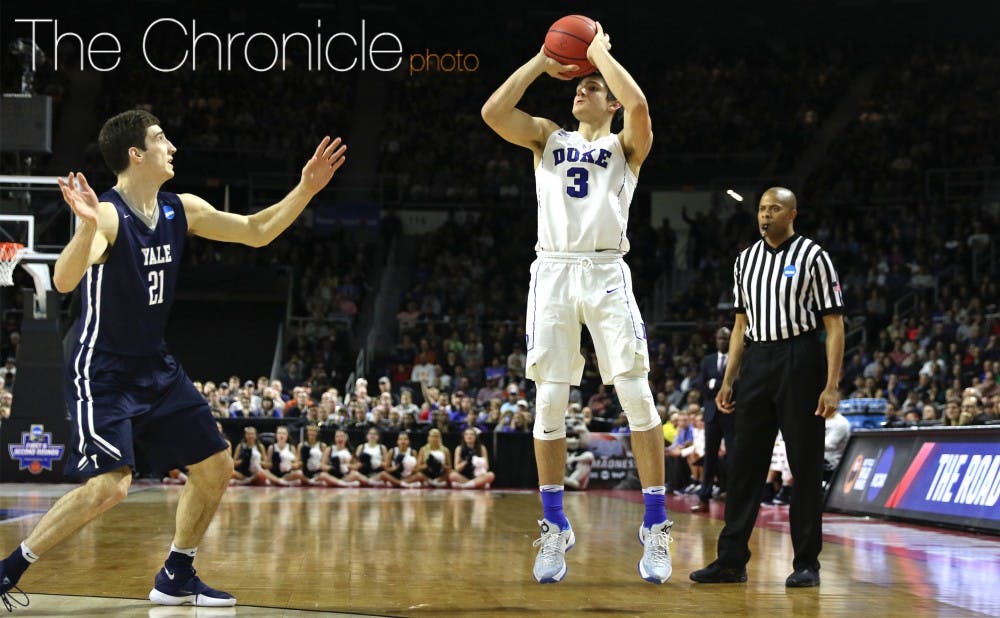ANAHEIM, Calif.—There were many terms thrown around Wednesday to describe an Oregon team that is largely unfamiliar to most of the country. Athletic. Versatile. Aggressive.
But one word came up time and time again, no matter who was speaking—unique.
After surviving a second-half scare from 12th-seeded Yale Saturday, fourth-seeded Duke is set to make its 23rd Sweet 16 appearance under head coach Mike Krzyzewski Thursday night at approximately 10:07 p.m. against top-seeded Oregon at the Honda Center. Tip-off is set for 30 minutes after the first West regional semifinal between second-seeded Oklahoma and third-seeded Texas A&M, with a trip to the Final Four on the line Saturday between the winners of the semifinal matchups.
The Ducks have quietly put together one of the most impressive seasons in program history, claiming both the Pac-12 regular-season title and conference tournament crown en route to the region’s top seed. Much like its national power football team, Oregon thrives on the hardwood with an up-tempo pace and aggressive style of play that forces opponents to make uncharacteristic mistakes.
“I don’t think there’s any direct parallel I can make—they have that unique of an identity,” Duke center Marshall Plumlee said. “They play at such a high level in that regard, so there’s not any one team I can single out that they’re like. They play an exciting, effective style of basketball, so we’re really going to have to prepare for it.”
Head coach Dana Altman’s lineup defies the traditional one-through-five mold, and every player possesses the ability to do damage both inside and out. The Ducks’ de-facto center—6-foot-10, 190-pound junior Chris Boucher—is third in the nation in blocks with 3.03 per game, but can also stretch the floor and ranks third on the team by knocking down 34.6 percent of his 3-pointers.
Oregon (30-6) maximizes its athleticism by employing a fluid seven-man rotation—with reserve forwards Dwayne Benjamin and Jordan Bell both averaging more than 20 minutes per game—and utilizing a pressure defense that can trap opponents in the backcourt. Even for a Duke team that withstood the rigors of a full ACC schedule, there is still a great deal of uncertainty as to what playing against the Ducks will be like.
“We don’t watch [Oregon]—you know, we watch our own neighborhood,” Krzyzewski said. “What I have learned a lot in watching them now is just how athletic they are. They basically have seven starters, and they play off each other really well. They rebound. They play with a great verve. They’re a unique team because they don’t necessarily have that traditional low-post presence. One of their better 3-point shooters is their top shot-blocker, and I’m not sure that anybody has that.”
Krzyzewski pointed to Miami as an ACC squad that could be similar to Oregon, but noted the Hurricanes cannot block shots and move as well laterally as the Pac-12 champions. The Blue Devils (25-10) struggled in each of their two NCAA tournament games when their opponents turned up the defensive intensity, a weakness the Ducks are sure to try and exploit Thursday.
Oregon has compiled a 26-2 record when generating more steals than its opponents this season. With three starters in addition to Boucher checking in at 6-foot-6 or taller, the Ducks have plenty of length to clog passing lanes and wreak havoc on opposing offenses—an advantage the Ducks have translated into 14.2 forced turnovers per game.
“That’s the main thing, and we need to take care of the ball,” Duke freshman Luke Kennard said. “Oregon is going to pressure the ball, they’re going to try to force turnovers against us, but we can’t allow that to happen. We need to be strong with the ball, take care of it and get good shots.”
Sophomore Dillon Brooks is the key to the Ducks’ offense—the 6-foot-7 sophomore leads the team with 16.8 points and 3.1 assists per contest. At 225 pounds, Brooks has the frame to pound the ball inside as a stretch four and should present an intriguing matchup for Blue Devil freshman Brandon Ingram, who poses matchup problems in his own right and is Duke’s second-leading scorer at 17.1 points per game behind sophomore Grayson Allen, who will also command the Ducks’ full attention.
A first team All-Pac 12 selection, Brooks earned high praise for his versatility on both ends of the floor from Krzyzewski, who put the forward in the same company as ACC Player of the Year Malcolm Brogdon. Brooks has plenty of help from scorers Elgin Cook and Tyler Dorsey, who combine to average 28.3 points per game.
But Oregon hangs its hat on defense, and the Ducks take great pride in making opposing offenses uncomfortable. Ingram—who has a 7-foot-3 wingspan and shoots 41.5 percent from beyond the arc—drew the attention of several Oregon players during their film sessions, and they are determined to throw all of their considerable depth into stopping Duke’s latest freshman star.
“A guy who’s [6-foot-9], long like that, can dribble and shoot like that is always a problem. The ability to shoot 3-pointers and score baskets like that is the biggest thing that jumps off the table,” Benjamin said. “We have a lot of guys who can guard him for a couple plays, and just switch up the way we guard him. Elgin can guard him with physicality and maybe I come in with speed, but just the way we guard him is big.”
Get The Chronicle straight to your inbox
Signup for our weekly newsletter. Cancel at any time.

